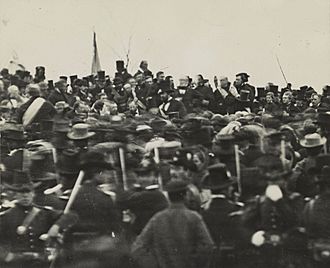Consecration of the National Cemetery at Gettysburg facts for kids

Abraham Lincoln (center) at the consecration just after arriving c. noon and ~3 hours before the speech. In 2006, two additional Gettysburg procession photographs of Lincoln were identified in the Library of Congress.
|
|
| Date | November 19, 1863 |
|---|---|
| Time | ~3 PM |
| Venue | Cemetery Hill, Gettysburg National Cemetery |
| Location | Gettysburg, Adams Co, Pennsylvania |
| Type | Ceremony |
| Participants | ~15,000 |
The Consecration of the Soldiers' National Cemetery was a special ceremony. It happened on November 19, 1863, at Gettysburg, Pennsylvania. During this event, U.S. President Abraham Lincoln gave his famous Gettysburg Address.
About 15,000 people watched the ceremony. Many important people were there. This included six state governors. Reporters from major newspapers like the Associated Press and The New York Times also attended.

Contents
Planning the Cemetery Dedication
After the big Battle of Gettysburg, many soldiers had died. A local lawyer named David Wills had an idea. He wanted to create a special cemetery for the fallen soldiers. This cemetery would be paid for by the states.
The governor of Pennsylvania chose Wills to buy the land. Wills bought about 17 acres for the cemetery. He paid $2,475.87 for the land.
Wills invited a famous speaker named Edward Everett to give a long speech. Everett was known for his amazing speeches. He needed more time to prepare his speech. So, the ceremony was moved to Thursday, November 19. President Lincoln was formally invited to participate on November 2.
Events Before the Ceremony
Starting on October 27, Union Army soldiers' bodies were moved. They were reburied in the new cemetery. By November 19, a speaker's platform was ready. About 1,258 soldiers had been reburied.
On November 18, President Lincoln arrived in Gettysburg. He came by train around 6:00 p.m. Lincoln walked to the Wills' house, where he would stay. A crowd gathered outside. Secretary of State William H. Seward spoke to them.
Later that night, Lincoln met with David Wills. Lincoln also met with Seward. He was serenaded by a singing group.
On November 19, around 9:00 a.m., Lincoln was still working on his speech. He kept writing until it was time to join the procession. At 9:30 a.m., Lincoln rode a horse to the cemetery. Many important people and townspeople joined him. They passed along Baltimore Street. Cannons fired every minute. The procession arrived at the cemetery around 11:00 a.m.
The Ceremony Program
The dedication ceremony had several parts:
- Music: Birgfield's Band played music.
- Prayer: Reverend T.H. Stockton gave a prayer. The cloudy day became sunny during his prayer.
- More Music: The Marine Band performed.
- The Main Oration: Hon. Edward Everett gave his speech. It lasted two hours and had 13,607 words. He talked about the battle and the war.
- Hymn: A hymn written by Benjamin Brown French was sung. The audience could see the battlefield and the Blue Ridge Mountains. There were still signs of the battle everywhere.
- Dedicatory Remarks: President Lincoln gave his Gettysburg Address. It was a short speech, only a few minutes long.
- Dirge: A choir sang a sad song.
- Benediction: Reverend H.L. Baugher gave a final blessing.
The program ended around 4:00 p.m. Lincoln left Gettysburg by train around 6:00 p.m.
What Happened After
After the ceremony, Lincoln's speech was sent by telegraph. Newspapers printed it the next day. The New York Times printed both Lincoln's speech and Everett's long oration.
David Wills asked Everett for a copy of his speech. Everett published a book about the dedication in 1864.
Today, a historical marker is in the Gettysburg National Cemetery. It says the speaker's platform was in Evergreen Cemetery. This is just to the left of the marker. For a long time, people thought Lincoln spoke from the Soldiers' National Monument. But studies in the 1990s showed the platform was actually on the Evergreen Cemetery side of the fence.


